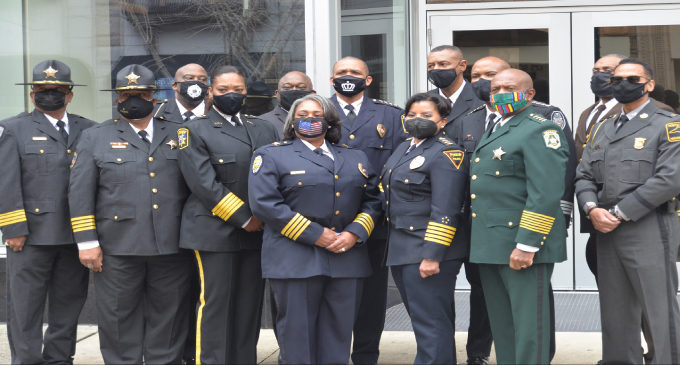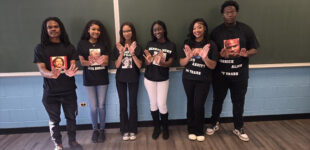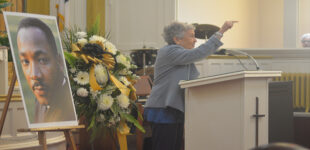Black law enforcement officers commemorate the historic Greensboro sit-in
On Monday, February 1, the top Black law enforcement officers in the state met at the International Civil Rights Center & Museum in Greensboro.

Movement to fight segregation spread to 13 states and 55 cities
On Feb. 1, 1960, four freshmen from N.C. A&T State University, Ezell Blair Jr. (Jibreel Khazan), Franklin McCain, Joe McNeil, and David Richmond, walked into the F.W. Woolworth Company department store in downtown Greensboro, sat down on the brightly colored seats at the lunch counter, and sparked a movement that would ignite communities across the country to fight against segregation.
To commemorate the 61st anniversary of that historic day, earlier this week more than a dozen top Black law enforcement officers in the state met at the former department store, which is now home of the International Civil Rights Center & Museum.
The commemoration event was planned by Chief Catrina Thompson, who is with the Winston-Salem Police Department (WSPD), and her staff. When discussing the event, Thompson said the Black sheriffs and police chiefs stood on the shoulders of people like the Greensboro Four. She said, “We stand on the shoulders of people like them and so many others who had the strength and courage to move forward. Quite frankly, I think that without people like them, people like us holding these positions would be impossible.”
Thompson said although we’ve made great strides, there is still work to be done. She said it’s clear that racism is still alive and she believes that the Black leaders in law enforcement are obligated to pave the way for the next generation.
“We’ve come a long way, but there is still work to be done,” Thompson said.
Others who joined Thompson at the commemoration ceremony included Mecklenburg County Sheriff Garry L. Rogers, Guilford County Sheriff Danny H. Rogers, Wake County Sheriff Gerald M. Baker, Durham County Sheriff Clarence F. Birkhead, Forsyth County Sheriff Bobby F. Kimbrough, Cumberland County Sheriff Ennis Wright, Pitt County Sheriff Paula Dance, Raleigh Police Chief Cassandra Deck-Brown, Greensboro Police Chief Brian James, Charlotte-Mecklenburg Police Chief Johnny Jennings, Fayetteville Police Chief Gina V. Hawkins, and Durham Police Chief Cerelyn J. Davis.
The International Civil Rights Center and Museum documents the story of the Greensboro Four. After more than five months of planning during what they called “bull sessions,” where they discussed ways they could dismantle segregation, that Monday afternoon they stopped talking and put their plan in action. The boys met at the library on campus and marched downtown straight to Woolworth’s and sat down at the “White Only” lunch counter.
At that time, it was Woolworth’s policy that all people of color had to order at the end of the counter and leave immediately after they got their food. Woolworth’s sold other items besides food, so when Blair, McCain, McNeil and Richmond entered the store that day, they purposely bought other items and got receipts before sitting down to prove they were paying customers.
They had only been sitting down for about a minute when they were told to leave, but not from whom you would expect. It was a Black woman who worked in the kitchen who saw what was going on and told them to leave. When discussing the woman in the documentary “February One: The Story of the Greensboro Four,” Blair said the woman told them “It’s people who like you who make our race look bad.” When the manager of the establishment realized that the young men weren’t leaving and he was losing business, he decided to close the store for the day.
But it didn’t end there.
Despite the situation getting more hostile, the next day Blair, Franklin, McCain and Richmond returned with even more people.
The peaceful protest continued for days and each day more people, both Black and white, joined the movement. By Feb. 5, nearly 300 students had joined the protest at Woolworth’s and by the end of March, the movement had spread to 55 cities in 13 different states, including here in Winston-Salem where 11 students from Winston-Salem Teacher’s College (now Winston-Salem State University) and Wake Forest College (now Wake Forest University) staged a sit-in at a lunch counter downtown.
That summer all lunch counters across the state were desegregated, all thanks to four freshmen who were willing to risk their lives to bring about change.
The documentary produced by FilmRise Features, “February One: The Story of the Greensboro Four,” can be viewed on YouTube. For more information on the International Civil Rights Center & Museum or to schedule a tour, visit www.sitinmovement.org.















